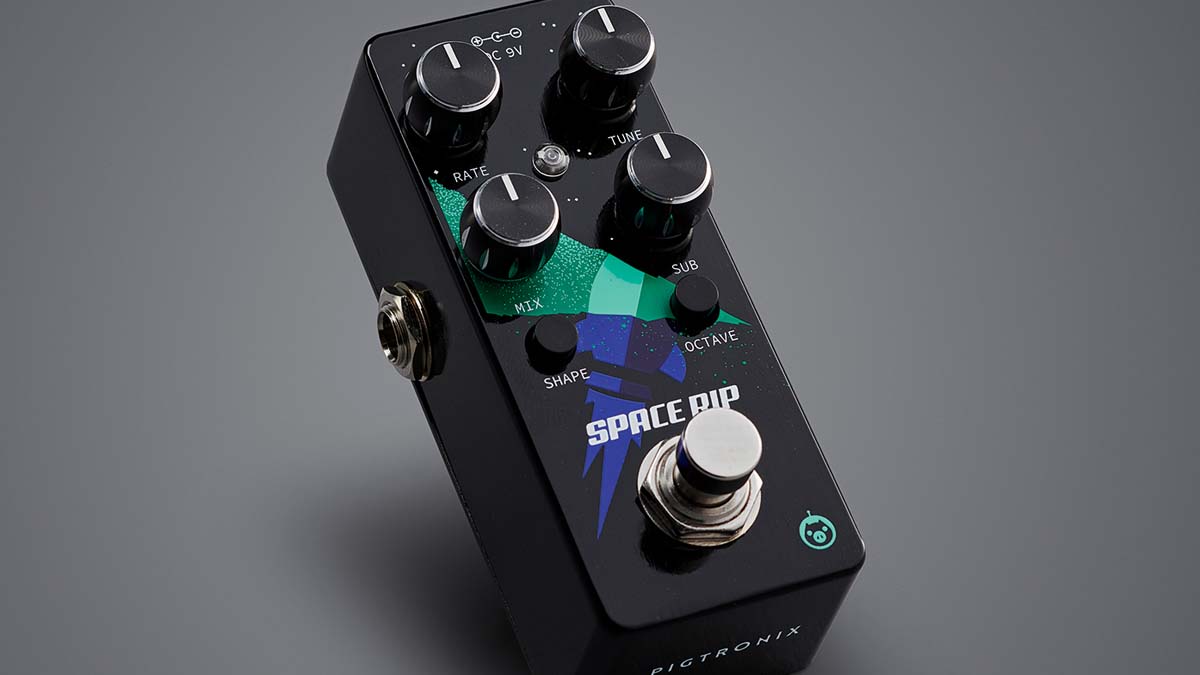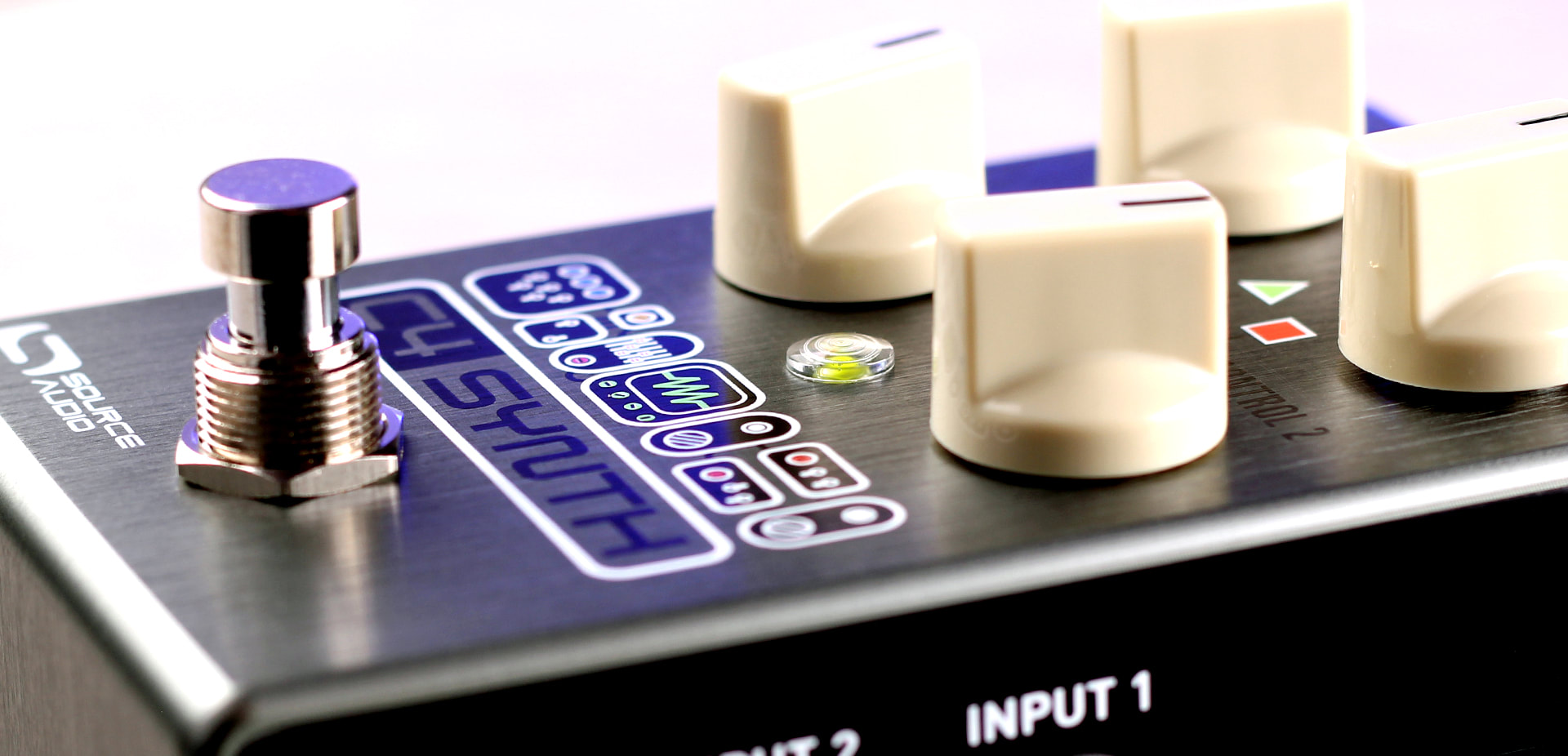MusicRadar Verdict
Careful technique and judicious edits via the Neuro app yield great synth sounds for electric guitar – some classic, some weird, and some very weird indeed.
Pros
- +
Impressive tracking.
- +
Source Audio gives you 128 presets.
- +
Neuro app is a deep-editing rabbit hole.
- +
Compact.
Cons
- -
Careful with your technique.
- -
Using an app to get the best out of a pedal isn't for everyone.
MusicRadar's got your back
Source Audio C4 Synth: What is it?
Think of Source Audio’s C4 Synth as a modular synthesizer in a pedal. That was the inspiration when Source Audio’s chief sound engineer, Bob Chidlaw, started the project: could all those sounds – sounds almost perfectly alien to the electric guitar – be placed inside the compact housing of a One Series enclosure?
Well, the answer is yes, yes it can, and like the other digital guitar effects pedals in the One Series lineup, the C4 Synth uses a combination of onboard controls and deep editing via the accompanying Neuro App (iOS/Android) or Neuro Desktop Editor (Mac/Windows) to offer an expansive range of sounds, and the ability to save and download presets, and to share sounds with the Source Audio user community.
Given how many options the C4 Synth’s four voice blocks, trio of oscillator wave shapes (sine, square, saw) and 20 filters present us with, the presets are very handy indeed – perhaps even crucial. The sounds available range from the vintage to the modern, from the conventional to the unorthodox. All in you can store up to 128 presets and access them via MIDI, and from six using the pedal’s onboard controls.

Those controls comprise dials for Input/Sensitivity, Mix/Volume, Control 1 and Control 2, with a three-way toggle switch for selecting your onboard preset bank. The Alternative button on the top of the unit access the secondary envelope sensitivity and volume functions, and allows you to access the second bank of pedal-accessible presets.
But to really get going with sound creation, you’ve got to reach for the Neuro app, which affords you comprehensive control over parameters. Once you find a sound you like, it’s simple; just save it down and you can recall it when you need it next.
Elsewhere, the C4 Synth has a USB input, a control input jack for hooking up an expression pedal, and there are a pair of standard inputs and outputs for stereo rigs.
Source Audio C4 Synth: Performance and verdict
The fact that you really need the app to use the C4 Synth effectively might put some people off, but it shouldn’t. For a pedal like this, an all-singing, all-dancing app is really the most efficient way to make the most of all the features on offer.
Want all the hottest music and gear news, reviews, deals, features and more, direct to your inbox? Sign up here.
Besides, the Neuro editor is intuitive and well thought out, and those presets make life easier further down the line.

• Pigtronix Space Rip
One small step for your pedalboard, one giant leap for electric guitar tone, with the Space Rip offering lots of fun with its saw and square-wave analogue synth sounds and massive octave effect.
• Way Huge Atreides Analog Weirding Module
One for sending your tone through the Twilight Zone, the Atreides might not be every player's cup of tea but it's sure to gain a cult following with the sonically adventurous.
• Electro-Harmonix Synth9 Synthesizer Machine
Overall, whether you want synth on its own or as a textural add-on for layering with your guitar sound, this pedal delivers it simply and cleanly, with blends to be explored that - when then sent through distortion and delay/reverb - can sound absolutely massive.
The quality of the sounds is impeccable. The tracking is superb. Of course, like all synth pedals, you have to give it information that it can process; so the cleaner your technique and phrasing, the better it will respond. But the C4 Synth’s performance opens up so many musical opportunities, and will reward adventurism.
Some players might throw their guitar tone through a monster pitch-shifted saw wave for electro-funk rhythms, others might dial in Pat Metheny-inspired sound that approximates his Roland GR-300, safe in the knowledge that the tracking will hold up for jazzy single-note runs.
The C4 Synth’s four voices are all independent, and can be mixed and matched, as can the three oscillators, and pairing the square wave oscillator with slower moving saw wave oscillators can summon some very cool sounds that work as well for guitar as they do for bass.
The options might seem bewildering at first, but once you start banking sounds, it all starts making sense, and those sounds are easy to augment via the Neuro editor, yielding new discoveries and – hopefully – inspiring new ideas. That, after all, is the point of such ambitious electrical endeavours.
MusicRadar verdict: Careful technique and judicious edits via the Neuro app yield great synth sounds for electric guitar – some classic, some weird, and some very weird indeed.
Source Audio C4 Synth: The web says
“As with any guitar synth, we’d remind you to be careful with your technique to avoid glitches, but the tracking here is generally slick and excellent, and you can dial in all manner of recognisable out-and-out synth sounds or just blend in a touch of ear candy weirdness for your dry sound. Overall, it's a compact and comprehensive source of synth sounds and textures.”
Guitarist
“Be prepared to create sounds akin to a space gamelan or alien sitar, with odd attack and decay qualities, rather than luscious beds of future-medieval oboe with predictable decay properties. An oscillator-driven keyboard synth, the C4 is not… If you’re on the prowl for more classic sounds, simpler is better, and starting with a single voice and a fairly regular waveform is a good start point.”
Premier Guitar
Source Audio C4 Synth: Hands-on demos
Sweetwater
Mike Hermans
Nobes Music
Do Noise
Guitar Bonedo
Source Audio C4 Synth: Specifications
- ORIGIN: USA
- TYPE: Synthesizer pedal
- FEATURES: Selectable analog buffered orrelay based true bypass, 128 presets
- CONTROLS: Control input switch, Input/Sense, Mix/Vol, 1, Control 2, Preset switch, control, Bypass footswitch
- CONNECTIONS: Standard inputs (1 & 2), standard outputs (1 & 2), USB, control input
- POWER: 9V DC adaptor (supplied) 165 mA
- DIMENSIONS: 70 (w) x 114 (d) x 51mm (h)
- CONTACT: Source Audio
MusicRadar is the number one website for music-makers of all kinds, be they guitarists, drummers, keyboard players, DJs or producers...
- GEAR: We help musicians find the best gear with top-ranking gear round-ups and high-quality, authoritative reviews by a wide team of highly experienced experts.
- TIPS: We also provide tuition, from bite-sized tips to advanced work-outs and guidance from recognised musicians and stars.
- STARS: We talk to musicians and stars about their creative processes, and the nuts and bolts of their gear and technique. We give fans an insight into the craft of music-making that no other music website can.

